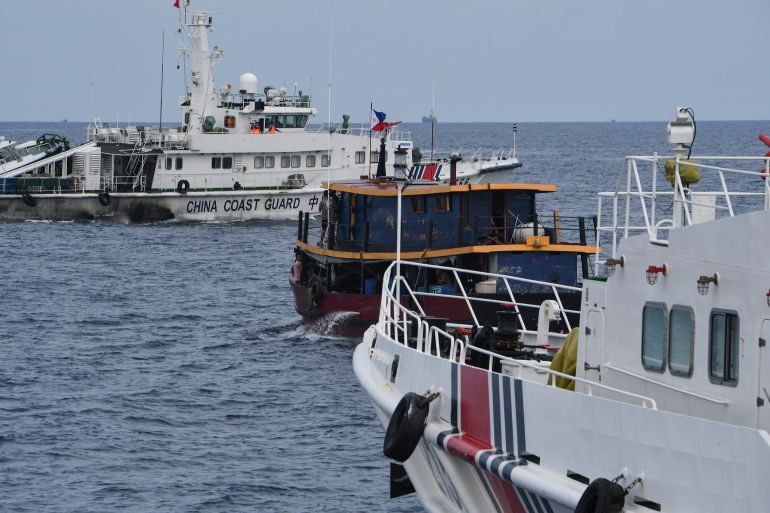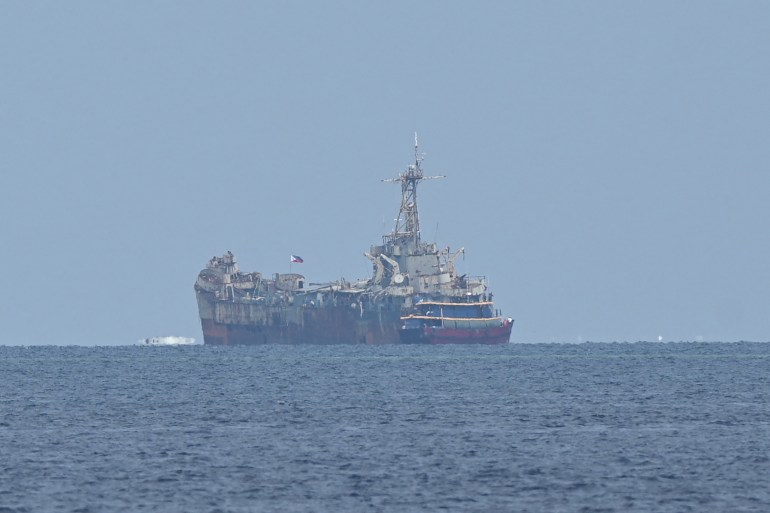Philippines supplies grounded South China Sea ship despite China threats
Philippine Coast Guard said Chinese vessels continued to ‘block, harass and interfere’ with its supply ships.

The Philippines has said it managed to get supplies to sailors on the grounded Sierra Madre in the disputed South China Sea, despite continued harassment from China’s Coast Guard and its maritime militia.
The Philippines grounded the Sierra Madre on Second Thomas Shoal, known as Anyungin Shoal by the Philippines, nearly 25 years ago in an effort to reinforce its claim to the atoll, which lies about 200 kilometres (124 miles) from the Philippine island of Palawan.
Keep reading
list of 4 itemsChina calls on Philippines to move grounded warship from disputed reef
Philippines summons China envoy after water cannon incident in disputed sea
China accused of using water cannon on Philippine boat in South China Sea
A number of sailors live on board the rusting ship and Manila carries out regular rotation and supply missions to the vessel, but earlier this month their mission was met with water cannon fired from Chinese boats. The incident led to an international outcry with the United States warning such threats to the status quo risked undermining regional peace.
Coastguard officials said this time China used smaller vessels that continued to “block, harass and interfere” with the Philippines’ two resupply ships, but on Tuesday they were able to outmanoeuvre the boats and get through.
The Philippine Navy was also on standby during the mission.
“We are not going to back down in exposing their aggressive behaviour in the West Philippine Sea,” Jay Tarriela, Philippine Coast Guard spokesman for the West Philippine Sea, told reporters on Wednesday, describing the confrontations with China as a “David and Goliath” situation.

China, which claims almost the entire South China Sea, has become increasingly assertive in its claims to the waterway, developing artificial islands and military outposts, and deploying its coastguard, maritime militia and fishing vessels against rival claimants.
The Philippines is among several Southeast Asian countries with overlapping claims to the sea, which it calls the West Philippine Sea.
In 2012, China wrested control of Scarborough Shoal, known as Panatag Shoal by Filipinos, a popular fishing ground within the Philippines’ exclusive economic zone under international law.
The Philippines sought an international court ruling on the so-called nine-dash line on which China bases its South China Sea claim, with the United Nations-backed court announcing in 2016 that the line had no legal basis.
Beijing has ignored that ruling and stepped up its activities in the South China Sea with the situation around the Philippines becoming increasingly fraught.
In February, Manila lodged a diplomatic protest after it said the Chinese coastguard engaged in dangerous manoeuvres and used a “military-grade laser” to try to block one of its supply ships near Second Thomas Shoal, which is more than 1,000 kilometres from Hainan, the nearest Chinese territory.
On Wednesday, Tarriela said the Philippines would continue to speak out on Chinese actions against its boats in the South China Sea.
“We’re going to continue this transparency initiative,” he said. “We believe this is our most effective tool in countering Chinese grey zone activity in the West Philippine Sea.”
With reporting by Zaheena Rasheed in Manila